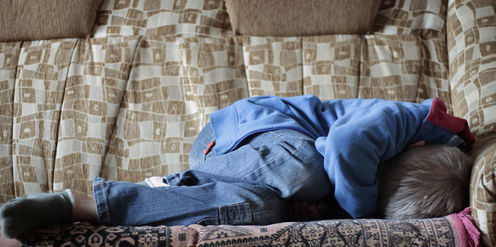
Headaches are uncommon in toddlers. But between the ages of three and seven, around 5% to 50% of children experience headaches of some type. From seven to 15 years, headache prevalence peaks at up to 75%. The vast majority of headaches experienced are tension-type headaches that don’t need specific treatment. But a quarter of these troublesome headaches are migraines.
Migraine headaches are the most common type of severe headache. They occur when networks of sensory and regulatory nerves deep in the brain are disordered. The details of exactly how migraines work are not yet fully understood but research in this area has made rapid progress, especially in the last decade.
Many adults who have a lifelong problem with migraines first experience them in childhood or adolescence. Migraine headaches occur in 15% to 18% of children, and the prevalence peaks between the ages of 11 and 13.
These figures are similar in adults. The worst 10% of adult sufferers account for 85% of the overall time lost to headaches. This suggests that if you don’t get effectively treated or grow out of your adolescent migraines, they may get progressively worse.
Much of the risk of having migraines is genetic so it is no surprise that two-thirds of childhood migraine sufferers have a family history of disabling migraine.
What causes childhood migraine?
There are some significant differences between migraines that occur early in life and those that occur later. A clear link between childhood adversity and migraine predisposition throughout life is emerging from current research.
The influence is likely to be complex and is currently poorly understood. It may well be that prolonged exposure of a developing brain to excessive stress causes neuroplastic changes or altered biochemistry that create a migraine-prone brain forever after.
Early onset of migraine symptoms indicates a child is at increased risk of a number of other conditions characterised by severe episodes of symptoms that occur in a cyclical fashion, such as abdominal pain, vertigo and torticollis (where the position of the head or neck is abnormal or asymmetrical). These “episodic syndromes” are highly distressing and disabling. They may reflect a common disorder of pain processing and are considered variants of migraine.
There are documented associations of early-onset migraine with emotional and behavioural difficulties. Understanding these relationships better will contribute enormously to potential prevention strategies but also perhaps to new treatment approaches.
The most common triggers for childhood migraine are similar to adults: emotional stress, sleep deprivation, skipping food, menstruation and weather.
Hormonal fluctuations during young women’s periods are one of the most consistently disabling trigger factors and many sufferers may need oral contraceptives to regulate hormone levels. It seems these common triggers may all increase oxidative stress (chemical not emotional stress) in the brain.
It will no doubt be welcome news that while chocolate remains a common scapegoat in headache causation, the scientific evidence for this belief is thin.
How to treat childhood migraines
It’s important to accurately evaluate frequent or severe childhood headaches given these children’s quality of life is severely impaired and the long-term impacts may be substantial.
The doctor needs to thoroughly explore psychological and social factors, which may require tact and time for trust to develop. School absences must be prevented or mitigated so the child does not fall behind her peers either academically or socially. Having a formal plan may help the school accommodate young headache sufferers.
The Royal Australian College of General Practitioners has published recommendations for GPs to use analgesics or migraine drugs (known as triptans) to treat migraine, but to also focus on addressing possible environmental, social, and psychological factors that could be at play.
Treatment of migraines in childhood support the idea that it is virtually a different disorder compared to adults. Thankfully, simple pain relief such as non-steroidal anti-inflammatories (NSAIDs) including aspirin and ibuprofen are more effective than in adults. Allowing the child to sleep if they want to is also very effective.
The triptans – standard drugs for aborting attacks in adults – do not seem to work as well in children. The response to medication becomes more “adult-like” after puberty.
First-line preventive treatments used in adults, such as propranolol (a heart medication), amitriptyline (an antidepressant) and sodium valproate (usually used to treat epilepsy) have not been thoroughly studied for efficacy in children, though they do appear safe for short- to medium-term use.
Decisions about prevention against frequent, disabling attacks require careful thought and are probably best done in conjunction with a paediatrician or paediatric neurologist. Treatment plans for preventing frequent and severe headaches may need to include input from a multidisciplinary team to ensure triggers are addressed by all available means, not just pharmacological ones.
In general, while migraine remains a lifelong predisposition when it starts in childhood or adolescence, the outlook is pretty positive. From the peak of the mid-teenage years, both the frequency and average severity of acute migraine attacks tends to drop off the older you get until a second peak in the 50s.
For such a common and disruptive condition, it is perhaps a bit surprising we don’t know more. Effective early intervention and well-organised diagnosis and treatment of childhood migraines may save severe adult sufferers from decades of underachievement and frustration.
Michael Vagg does not work for, consult, own shares in or receive funding from any company or organisation that would benefit from this article, and has disclosed no relevant affiliations beyond the academic appointment above.
